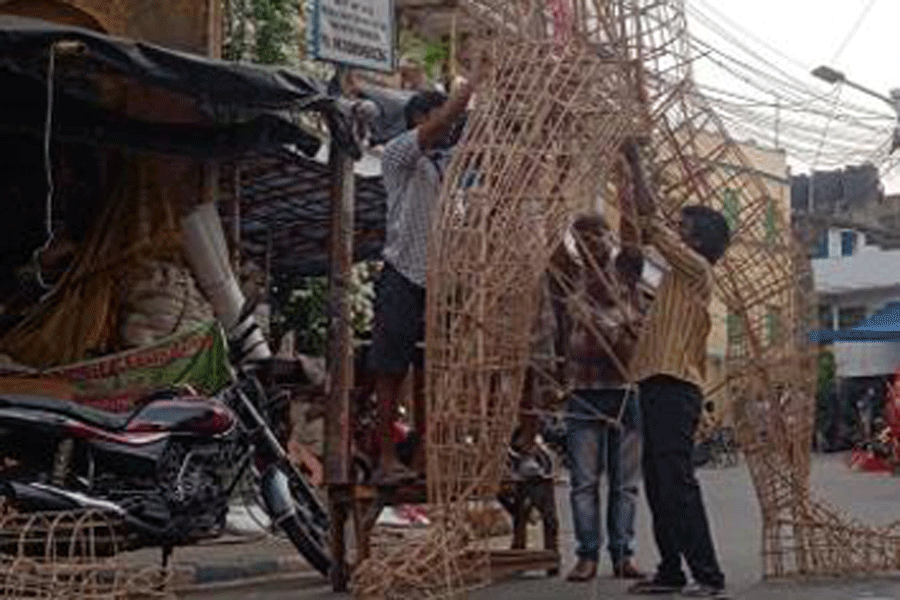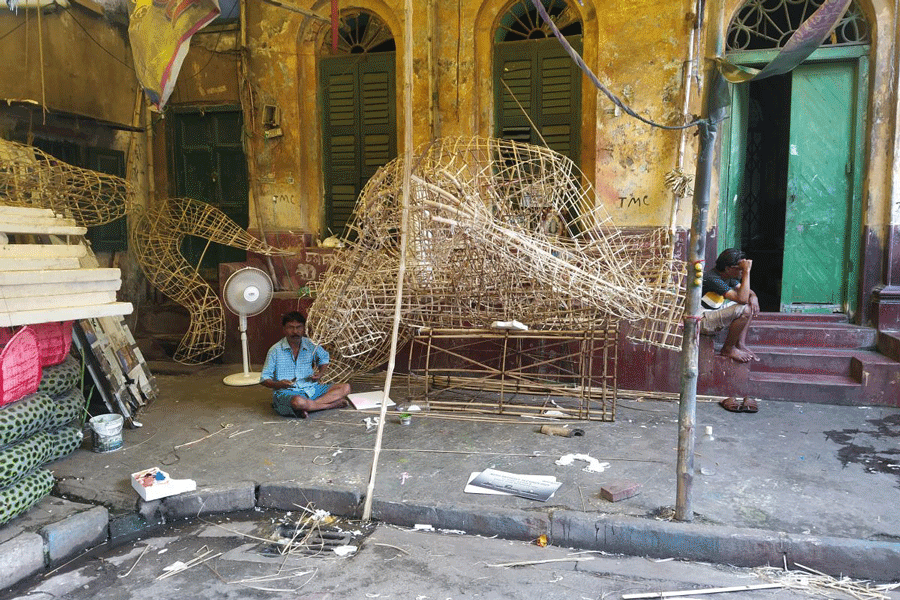Sudipto Maity, 32, is very busy. His smartphone keeps buzzing. Durga Puja organisers who want to sign him up for pandal decoration have to contact him at least six months ahead of the big event. The remuneration is handsome. This year, he is collaborating with well-known artist Partha Dasgupta. Maity’s peak season begins with the monsoons, just before Viswakarma Puja in September, and ends with Saraswati Puja.
Maity was born into a family of craftsmen in central Calcutta’s Dompara, also known as Rambagan. But Maity’s father and uncles didn’t have it so good. Until 1976, the inhabitants of Dompara were underemployed and exploited as any labouring community was and continues to be.
Maity himself is a graduate of Calcutta’s Government College of Art and Craft. Dasgupta, however, says, “No formal art school can teach you such skills. I am astoun-
ded to see how effortlessly he and his teammates create three-dimensional structures out of split bamboo or cane from my sketches.”
One of their latest creations is a chariot based on the photograph of a 19th century wood engraving by Ramdhan Karmakar. Dasgupta showed it to them and they recrea- ted the whole thing within days. Dasgupta himself has designed the pandal for Purbachal Shakti Sangha in Haltu in southeast Calcutta.
Maity and Dasgupta wanted me to see how these folk artisans work, so they took me on a guided tour of Ramesh Chandra Datta Street beside Liberty Cinema in the heart of Dompara.
Out in the open, on the streets, dozens of bare-bodied artisans are weaving intricate structures out of bamboo and cane. For these traditional artists, streetsides are their sketchbooks. First, they scribble the designs on the pavement with chalk or white paint. Then they set the split bamboo strips beside the sketches and build away elabo-
rate archways or small parts of a larger installation based on the drawing. These parts — prefabricated structures — are transported to pandals in different parts of the city and the state and fitted together by artists on site. I am told some of the frames travel far beyond Bengal and India.
That day, septuagenarian Bhupen Malik is working on a part of a pillar. He learnt the craft from his father and grandfather. He narrates how these very streets used to be dark, dinghy and home to an extended filthy slum when he was a child in the 1950s. Bhadraloks avoided these lanes even during the day given their proximity to Rupagacchi, the red-light area and less famous twin of Sonagachi.

Artisans weave intricate structures out of bamboo and cane. Courtesy: Partha Dasgupta
Those days, the children of Rambagan didn’t have access to schools. Uneducated and unemployable, many of them naturally drifted to the world of petty crime.
Malik says, “Those belonging to the upper castes looked down on us as we are doms. Our forefathers were considered untouchables.”
Dom is the word commonly used for someone who handles corpses in crematoriums, morgues or hospitals. But it is also the name for those people of Midnapore who worked as musicians or basket weavers. Some say the Bengali children’s rhyme “Agdum baghdum ghoradum shaaje” gestures to the different occupational categories among doms; dum being a corrupted version of dom.
An aside. In the heart of Rambagan once lived ICS and economic historian Romesh Chunder Dutt. This would be mid to late 19th century. His relations, sisters Toru and Aru Dutt, lived in the same house. Since their family had converted to Christianity, they were ostracised by the local gentry and were compelled to employ doms as domestic help.
Malik had heard from his grandfather that Rambagan is older than Calcutta. Apparently, when their ancestors arrived in the late 17th century, the area was an island of sorts in a forest of Hogla, a giant aquatic grass. In the initial days, the inhabitants used to weave jhnaka or big baskets for the local bazaars and chupris or small baskets to supply to the nearby Kali temples.
These men, however, got some recognition and acceptance only in the 20th century, when two social outfits — Jana Kalyan Samiti and Karmi Brinda — organised their lot into artisan units and publicised their skills.
We walked to the premises of Karmi Brinda, which was created by the late Jiban Krishna Ghoshal, a teacher living in the neighbourhood. We walked down the narrow street and into a three-storey building. The top floor is for women artisans and the other two floors are the preserve of male artisans.
Master craftsman Sapan Ghanti has trained many of the youngsters in the neighbourhood. He took us to the office of the organisation, where he pointed to three framed photographs — Jiban Krishna Ghoshal, Bimal Dutta and Anil Chatterjee.
Ghoshal was one of the early patrons of Karmi Brinda, Dutta used to own this house and Chatterjee was officer-in-charge of the Jorasanko police station in the mid-1970s.
Says Ghanti, “We are grateful to these three souls.” There was a time when local policemen did not allow the artisans to work in the open. It was then that Chatterjee intervened.
Ghanti shows us how they use the jaant, the sharp edges of three knives fixed on a wooden plank, to cut long strips out of cane or bamboo.
The strips or threads can be used to create fascinating pieces of furniture and even ornate bangles, earrings and pendants. He takes out samples of his creations from an iron safe. The 68-year-old says, “I lost my eyesight working on these for decades.” He adds that bamboo statues of gods and goddesses created by Dompara artisans are preserved in many museums in India and abroad.
According to Ghanti, Karmi Brinda’s pandal decorations for Durga Puja received considerable recognition for the first time when they came to be associated with the Durga Puja at Muhammad Ali Park. This helped them bag a big contract with Shree Swaminarayan Mandir Trust in Ahmedabad. In the 1980s, the central government asked them to work on decorations for the India Festival in London.
Since then there has been no looking back. Most Kumartuli idol makers come to them with requests/orders to create the chaali or backdrop of the Durga idol.
It is past evening when Maity takes us to Janakalyan Samiti and R.K. Mission School and Training Centre. Right outside the school, a group of pre-teens is helping adults make frames of bamboo gates. A client from Baguiati is animatedly explaining the intricacies of their Puja assignment to two craftsmen.
I take aside one of the boys — Poltu — and ask him what the fuss is all about.
He says, “That’s a picture of Chandrayaan-3 they want us to create in their pandal.” He adds, “It’s a cakewalk for my father.”
Lazy Eye is on a sabbatical











